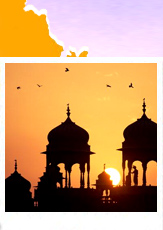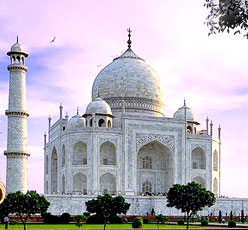With a history that speaks of several
rulers, it is little wonder that one finds forts in Goa. Certain witnesses
of the past, in form of forts, still remain. There are a few forts in Goa
that have stood the test of time and have a lot to say of the years gone.
Fort Cabo da Rama
Cabo da Rama is located on the southern coast of Goa, this fort has been
under the regime of various rulers until the Portuguese took it over from
the Raja of Sonda in 1763. After taking charge of the fort, the Portuguese
rebuilt it but did not put it to much use thereafter. It came under the
British rule from 1797 to 1802 and then again from 1803 to 1813. After that,
not much attention was paid to the fort. The remains of the fort were then
used as a prison until 1955.
Though the church within the fort is still in use, there is little of the
fort that remains to be seen today. However, the view from the headland is
breathtaking. According to legend the fort has derived its name from Lord
Rama who remained here for a while when he was in exile, along with his
wife, Sita.
Fort Chapora
The Portuguese had won their rule in Goa but the threat from the Muslim and
Maratha rulers went on. To protect themselves from this risk, the Portuguese
built the Chapora fort in 1617. However, unlike the Aguada fort, this fort
did not remain unconquered.
The Portuguese troops surrendered to the Maratha ruler, Sambhaj in 1684.
But the locals were not too pleased with this and had a number of conflicts
with the Marathas and finally in 1717, the Marathas withdrew their force.
The Portuguese then took over again and rebuilt the fort. The new structure
of the fort was equipped with underground tunnels that ensured a safe
getaway in case of an emergency.
But this glory was not for long. As again in 1739 the Marathas captured the
Chapora fort. However, two years later, in 1941, the Portuguese regained the
fort when the northern taluka of Pednem was handed over to them.
However, the Portuguese completely abandoned the fort In 1892. And what
remains today are only ruins. Though, there isn't much to see, the history
lingers on.
Fort Aguada
Fort Aguada is strategically situated at the estuary of the river Mandovi,
this fort was constructed in 1612 as a guard against invasions from the
Dutch and the Marathas. The walls of this fort are 5 mts high and 1.3 mts
wide. Little surprise then that this remains to be the only fort that was
not conquered by any invaders during the 450 yearlong rule of the Portuguese
empire.
"Agua" in Portuguese means water, thus the fort derived its name "Aguada"
to denote a place where water is accumulated.
The area around the fort housed a large well and a number of springs that
provided fresh drinking water to the voyagers that arrived by ship.
An interesting feature in the majestic fort is a 13 mt high lighthouse.
This lighthouse, built in 1864, initially used an oil lamp. It was later
renovated and modernised in 1976. This lighthouse was home to a gigantic
bell that was retrieved from amongst the ruins of the St. Augustus monastery
at Old Goa. However, the bell has now been moved to the Our Lady of
Immaculate Conception church at Panaji.
Though the entire fort is no longer intact, some buildings that are still
in good shape have been converted into a prison. Interestingly, it happens
to be the largest prison in Goa.
En route to the fort, one comes across the church of St. Lawrence, the
saint of the sailors. The Portuguese used to build churches on the outskirts
of the forts to prevent the enemy from firing at a close range.
Fort Terekhol
Terekhol fort situated on the Terekhol River, lies on the northern tip of
Goa, on the hillock overlooking the Arabian Sea. In its courtyard is the
century old church of St. Anthony. Maharaja Khem Sawant Bhonsle built this
fort in the 17th century but it was rebuilt in 1764 after the Portuguese
Viceroy Dom Pedro Miguel de Almeida captured it.
The remains of the fort have now been converted into a hotel, the Terekhol
Fort Heritage. However, the St. Anthony's church inside the fort still
remains. But it is not open to the general public except on certain
occasions such as the annual feast that is usually held some time in May.
India's travel agent and tour operator offering Goa travel information, tourism in Goa and Goa tours and travel packages.
Travel to India: Goa Travel Guide: Forts in Goa









